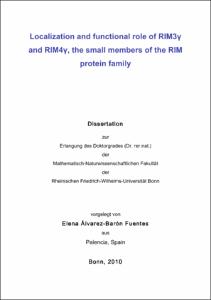Localization and functional role of RIM3γ and RIM4γ, the small members of the RIM protein family

Localization and functional role of RIM3γ and RIM4γ, the small members of the RIM protein family

| dc.contributor.advisor | Schoch, Susanne | |
| dc.contributor.author | Álvarez-Barón Fuentes, Elena | |
| dc.date.accessioned | 2020-04-15T14:26:14Z | |
| dc.date.available | 2020-04-15T14:26:14Z | |
| dc.date.issued | 19.05.2010 | |
| dc.identifier.uri | https://hdl.handle.net/20.500.11811/4573 | |
| dc.description.abstract | RIMs are Active Zone enriched multidomain proteins. In vertebrates, the RIM family is composed of 7 proteins (RIM1α, 2α, 1β, 2β, 2γ, 3γ and 4γ) encoded by four different genes (RIM1-4). The large members of the RIM protein family are central components of the cytomatrix at the Active Zone and play a key regulatory role in synaptic vesicle exocytosis and presynaptic forms of short- and long-term plasticity. However, so far little was known about the localization and function of the γ-isoforms. The focus of this study was to gain further insights into the physiological properties of RIM3γ and RIM4γ. Therefore, we first investigated their localization. We found the regional distribution of both γ-RIMs to overlap with the full-length isoforms, however, they exhibited a diverging regional and subecellular localization. RIM3γ was presynaptically localized, whereas RIM4γ was not restricted to the synapse but also present along the axon and dendrites. In addition, we studied the γ-RIM domains and sequences responsible for the targeting of the proteins, and found the C2B domain to be sufficient for the presynaptic localization of γ-RIMs. Furthermore, we observed that coexpression of the γ-isoforms with RIM1α, but not with Liprins-α, can promote their synaptic localization. In order to delinate the function of the γ-isoforms, downregulation of the proteins was performed using lentiviral transduction in primary neuronal cultures and in vivo. RIM3γ or RIM4γ knock down neurons displayed a striking change in neuronal morphology, whereby they mantained the axon but lost most of their dendrites. In addition, downregulation of γ-RIMs, led to a decrease in the levels of RIM1α, Liprins-α and GRIP1, suggesting a possible role for γ-RIMs in neuronal morphogenesis, likely via a cascade involving Liprin-α and Liprin-α binding proteins. | en |
| dc.language.iso | eng | |
| dc.rights | In Copyright | |
| dc.rights.uri | http://rightsstatements.org/vocab/InC/1.0/ | |
| dc.subject.ddc | 570 Biowissenschaften, Biologie | |
| dc.title | Localization and functional role of RIM3γ and RIM4γ, the small members of the RIM protein family | |
| dc.type | Dissertation oder Habilitation | |
| dc.publisher.name | Universitäts- und Landesbibliothek Bonn | |
| dc.publisher.location | Bonn | |
| dc.rights.accessRights | openAccess | |
| dc.identifier.urn | https://nbn-resolving.org/urn:nbn:de:hbz:5N-21263 | |
| ulbbn.pubtype | Erstveröffentlichung | |
| ulbbnediss.affiliation.name | Rheinische Friedrich-Wilhelms-Universität Bonn | |
| ulbbnediss.affiliation.location | Bonn | |
| ulbbnediss.thesis.level | Dissertation | |
| ulbbnediss.dissID | 2126 | |
| ulbbnediss.date.accepted | 25.03.2010 | |
| ulbbnediss.fakultaet | Mathematisch-Naturwissenschaftliche Fakultät | |
| dc.contributor.coReferee | Haas, Albert |
Dateien zu dieser Ressource
Das Dokument erscheint in:
-
E-Dissertationen (4442)




